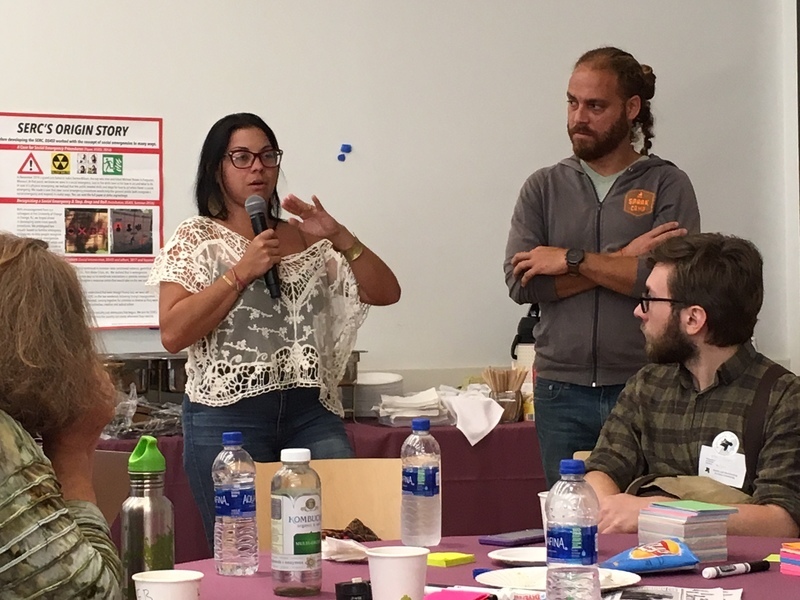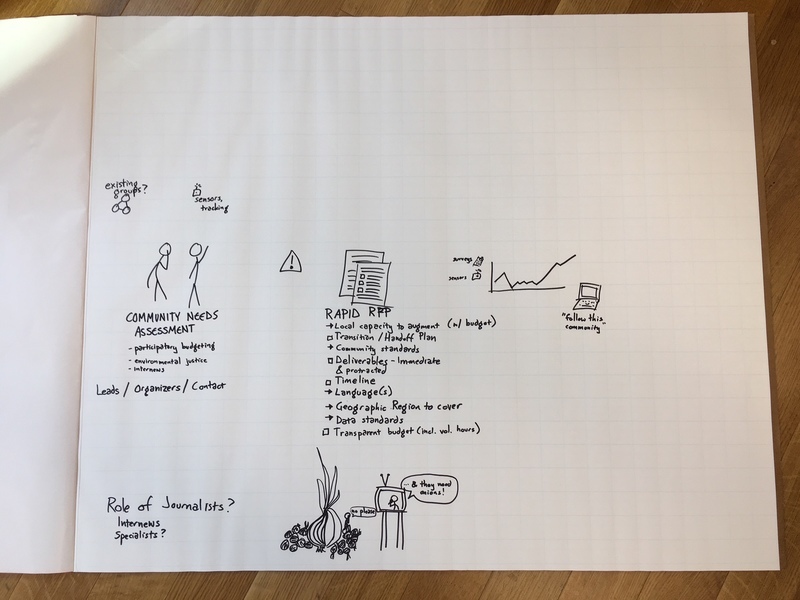This Northeast regional Barnraising was like no other because it started with people exchanging stories of disaster. It was an appropriate ice breaker since the first day was dedicated to crisis convening. I shared my experience of an earthquake that hit while I was at a café in Philadelphia. I remember my inner dialogue went from "possible subway work" to "nearby construction" to the gut instinct that this was an earth shaking event. How much time did I lose arguing with myself? What would I do differently next time? As others shared their encounters questions arose: How many people have experienced natural disasters? What does emergency relief look like? What should it look like?

It's hard to compare a small earthquake that merely puts people on edge, to a hurricane with flooding that causes loss of homes, jobs, food and electricity. Testimonies from flood survivors, (who I'm now renaming flood wranglers) provided details of rising waters and destruction in so many communities---New Jersey, Texas, Florida, El Salvador and Puerto Rico. I know I was swept by the emotions of sadness, fear and anger hearing about their situations. Yet there were also stories of community leaders, bartering and rebuilding that brought hope. After another day of Barnraising, the stories started to sound similar. In fact, you could have exchanged locations and faces, but the same problems were surfacing.
- People were not being helped
- Governments were failing to respond efficiently (or not at all)
- Communications failed
- Systems were not in place for food and water
The greatest thing about a
Barnraising is that it not only provides a safe place to discuss problems, but
it also encourages sharing current solutions while working on new ones. One of
the best tools I heard presented was the common bicycle. They can be
used for transporting supplies and medical aids, as they are
nimble when most roads are jammed or impassible. Bikes are also able to be
hacked to become generators to recharge phones--that's something everyone
should have in place!
One of the sessions that got
me most excited was creating a "Communication Checklist". Solid ideas were put
on paper about the best ways to communicate during a disaster when electricity
fails. Details include using flyers with bold/cultural images to communicate
meeting places and times, connecting with community leaders, using libraries as
hubs, encouraging face-to-face communication and supplying printouts of
resources.
Choices of resources are often not controlled by communities, and one session addressed that problem by creating a blueprint for a Rapid RFP (Request for Proposal). It includes a transition/handoff plan, deliverables, timeline and transparent budget. This entire process would help to ensure that a community receives the right help it needs and would also put into place a checks and balances for how the process is working out.
Checks and balances is probably just the shadow of what I encountered on this Barnraising. The most memorable part was hearing quavering voices as truths were shared across all disasters including government mistrust, racism, receiving inappropriate supplies, neglect, hunger, sickness and homelessness. Still these discussions are so fresh in my mind and I'm so thankful for those that were able to stand up in front of the group and be so honest. We need to hear this---the world needs to hear this. So, what can we do to make disasters less disastrous? Here's what I learned so far:
- Start making connections with your community now to prepare---leaders and resources
- Despite mistrust, we must work to communicate with government so they become partners
- Have a plan of action for your household and family members including supplies
- If disaster strikes a community other than your own, make sure you are invited to help by the community or from a trusted resource of that community. The history of the community is an important consideration and a great example can be found on this post about the situation in Puerto Rico.
- Money doesn't solve the problem in larger disasters---be ready to barter and share
- Use the connections made at Barnraising to boost our network and join to help
We cannot escape that all things are interconnected and I know that I'm still learning how to ask for and accept help. For those that attended the Barnraising, please do add in your thoughts on what you learned or what could be helpful in a disaster. I remain in awe of flood wranglers and those serving in disasters.


3 Comments
It has been strange to track FEMA over the years. Initally, say 30 years ago, they said you needed three days of food and water. Then it changed to a week's worth of food and water. After some of the recent disasters ( say Puerto Rico), that is on the low side.
We lost power for a week in the middle of winter. There was no way we could afford a generator. We did OK with hurricane lamps and kerosene heaters. But still, it feels like a lot is missing. Thank you for your work.
Reply to this comment...
Log in to comment
@Ag8n That is interesting to hear about supplies and my friend in Florida mentioned she has a few weeks worth for her stockpile.
Reply to this comment...
Log in to comment
My major concern is about water. Yes, we have 5 gal jugs of water on hand. But only a few of them. We live in a rural area, and in a power outage there are very few manual pumps around for the wells.
As for food, we preserve some of our own food ( both pressure can and cold pack). We used to have a large garden, too. But now it is less expensive to purchase it from Amish farmers.
Reply to this comment...
Log in to comment
Login to comment.